Editor's Note
March 22 marks this year’s World Water Day and the start of the following China Water Week from March 22 to 28. The theme of the 2025 World Water Day, Glacier Preservation, calls on the global community to protect our planet’s precious frozen freshwater resources. To raise the awareness about this urgent mission, the United Nations has designated March 21, one day before the World Water Day, as the World Glacier Day, beginning from this year.
In celebration of the World Water Day and China Water Week, and to highlight China’s achievements in water resources development and its contributions to the global water sustainability, the Chinese government has set the theme of China Water Week 2025 as “Promoting High-quality Development in the Water Sector for National Water Security.” In response to this initiative, IWHR has published a special series of feature articles, exploring cutting-edge developments in smart dam construction, digital twin technologies, river ethics, and the National Water Network.
This series showcases the institute’s contributions to national strategies, livelihood improvement, scientific and technological advancement in the water sector, and international cooperation. It also highlights how innovations in water science and technology are shaping new productive forces and contributing to global sustainable development.
On this blue planet, water is the source of life and the foundation of development. As key hubs of water projects, dams play an irreplaceable role in flood control, irrigation, power generation and water supply. However, at this era when global climate change and the impact of human activities are intensifying, dam safety is facing unprecedented challenges.
Entering the 21st century, climate change continues to intensify, heavy rainfall, floods and other extreme weather frequently attacks; the impact of human activities are becoming more pronounced, the construction of surrounding projects, resources development and other factors are changing the operating environment of dams; and as the serving period of the projects growths, a number of dams are facing varying degrees of aging problems. All these combined factors have threatened the safety and stability of dams. Once a dam fails, the flooding will cause devastating results to people's lives and properties downstream, seriously affecting socio-economic development.
As one of the leading countries in dam construction, China has about 95,000 reservoirs and dams of various types, ranking first in the world in terms of the number of dams, the number of high dams and the total installed capacity. Facing new environment, engineering conditions and the needs to ensure dam safety, Chinese government attaches great importance to the construction, operation and management of reservoirs and dams, continuously improves the level of construction and management of reservoirs and dams, puts the safety of people’s lives in the first place, and prioritizes the safety of reservoirs and dams. Chinese President Xi Jinping has put forward the water governance philosophy of "prioritizing water conservation, pursuing spatially balanced development, conducting systematic governance and harnessing the synergy of government and market”, emphasized adhering to the "integration of development and safety” and the “harmony between humanity and nature”, as well as "strengthening the construction of digital infrastructure, leading the way forward for the water sector. In recent years, the Ministry of Water Resources of China (MWR) has been promoting high-quality development in water sector, while combining the needs to ensure flood safety and water resources allocation, fully implementing and pacing up water modernization, and vigorously promoting the construction of digital twin water projects and smart dams in accordance with the principle of "demand-driven, application-first, digital empowerment, and capacity enhancement".
As the water resources development thrives in China, China Institute of Water Resources and Hydropower Research (IWHR) stands firm at the forefront. Guided by the top water governance philosophy proposed by President Xi Jinping, IWHR, being the active practitioner responding to the decision-makings and deployments from the MWR, has made research progress and achievements in the field of smart dam construction.
Smart sensing: the intelligent “five senses” of dams
Smart sensing is the function enabling dams to gain “five senses”. IWHR, through the research and development of monitoring and testing technology, equipment and facilities, has constructed an integrated "sky-space-earth-water works " sensing system. By using optical remote sensing satellites, dam hazards could be identified smartly, so as to quickly find the potential risks of the dam and surrounding areas from the macro perspective. The technological integration of GNSS, InSAR, UAV and monitoring sensors enables an all-round monitoring of the reservoirs and dams and the deformation of upstream and downstream slopes. Machine vision-based technologies on monitoring surface displacement deformation, and technologies on monitoring the water level based on videos and images, "stand for the safety of dams from different angles.

Deformation rate map of the Longkou Reservoir in Shenzhen
Based on the magnetic grid technology with high precision, strong anti-interference ability and durability, the wearable slope deformation monitoring device, a set of new slope spatial deformation monitoring system with independent intellectual property rights, protects the safety of the left abutment debris of the Xiluodu Hydropower Station. Magnetic silt pressure monitoring device and magnetic grid flexible inclinometer were installed and operated in Shaanxi Dongzhuang Water Hub Project, which will play a key role in safety monitoring the high arch dam during the construction and operation.
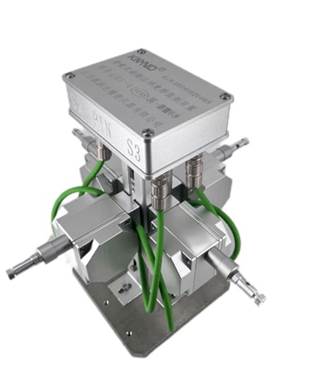
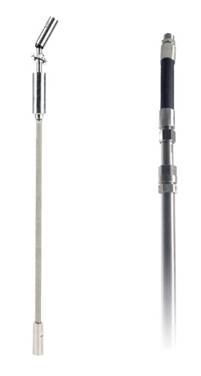
Magnetic Grid Monitoring Sensors
To tackle the problems of underwater structural inspection, IWHR has developed the robot for inspecting the exterior and internal defects of underwater structures, which has performed well in inspecting defects of underwater structures including dams, sluices and piers in Fengman Hydropower Project in Jilin Province and New communities of Xiong'an New Area, Hebei Province. At the same time, IWHR has also made breakthroughs in the recognition method of exterior defects in turbid and disturbed environment, featuring an underwater acoustic-optical inspection system that has reached centimeter and millimeter level in detection accuracy for acoustic and optical defects respectively, with detection accuracy up to 95% and defect recognition accuracy up to 90%, greatly supporting the thorough sensing of safety risks of the dam project.
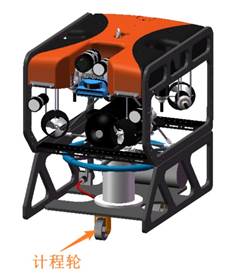
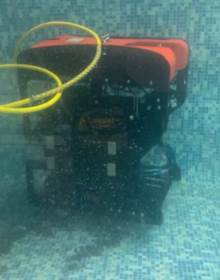
Underwater robot
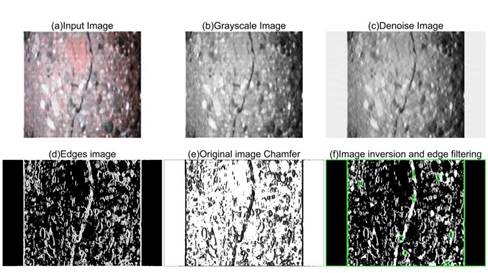
Quantitative identification of surface cracks on underwater structures
Smart analysis: intelligent diagnosis for dam safety
Smart analysis is the "brain" of smart dams. IWHR has developed cutting-edge simulation algorithms and models to deeply mine and analyze dam operation data, providing a scientific basis for dam safety assessment and decision-making.
Regarding the development of simulation algorithms, IWHR has developed the efficient search technology by utilizing the efficient identification algorithm of unit group boundary surface and the fine search algorithm of EAB contact theory based on DDA; the automatic update technology of model topology based on the reconstruction algorithm of finite element node separation unit, the fast update algorithm of topological relationship and the fast update algorithm of the storage structure of stiffness matrix equation. Relying on the cracking-expansion-disaster simulation technology based on FEM and DDA, the simulation of the whole process evolving from fine cracks to disaster of the dam is achieved. The use of spatial ground vibration input method based on the subdomain reduction approach, and concrete FEM-DEM dynamic multi-scale simulation technology, both enable more accurate response analysis of the dam under extreme working conditions such as earthquakes.
Regarding the research and development of the model platform, IWHR has developed a software platform for simulating concrete dam lesions and calamities with the integration of input, analysis and output. The platform was applied in simulating and analyzing the cracking conditions on the downstream face of the Ertan Arch Dam Project, and the results were generally consistent with the on-site inspection, which verified the method and software. In addition, the single-measurement point and multi-measurement point stress-strain time-sequence prediction model based on TFT neural network developed by IWHR has excellent performance in engineering applications, with higher accuracy and easy maintenance in multivariate long time-sequence prediction compared with the traditional model. The dam stress field proxy model based on MLP and dam stress field reconstruction model based on measured data have enabled the reconstruction of the stress field of the dam under the condition of sparse monitoring and the efficient prediction and analysis, which provide a good solution for the monitoring and early warning of dam construction and operation safety.

Software platform for simulation of lesions and calamities of high concrete dams
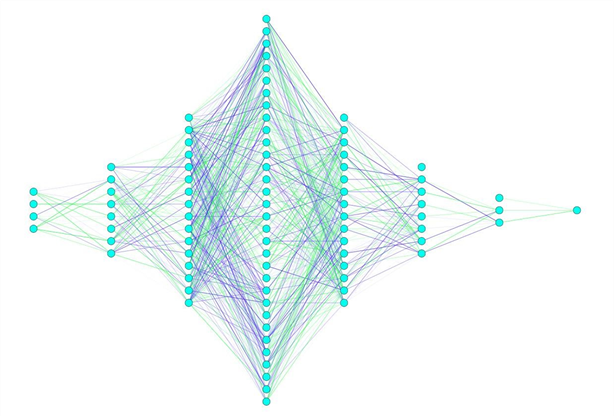
Multi-Layer MLP Network Diagram (stress field reconstruction model)
Digital twin water projects: creating a "virtual twin" of the dam
Digital twin is the "representational form" of smart dams. By constructing a virtual twin model that is highly similar to the physical dam, it realizes real-time monitoring, accurate simulation and intelligent decision-making for the whole life cycle of the dam. IWHR is dedicated to promoting the construction of digital twin water projects. To ensure dam safety and optimize the regulation, IWHR focuses on overcoming the difficulties in monitoring data governance, constructing mechanism model, synchronous simulation and efficient preview, and real-time assessment and risk early warning, etc. Accordingly, IWHR has carried out researches and developed a digital twin system for dam safety analysis and early warning.
In terms of monitoring data management, based on the existing workflow of " initial screening by system→ gross error discrimination → manual calibration", the manual calibration rules are quantified, and the automated calibration rules and processing methods are established to provide high-precision data baseboard for digital twin dams. In terms of model construction, IWHR has proposed three-dimensional block cutting and shaping algorithm for complex geological structures, large-scale parallel grid dissection algorithm and uncoordinated grid bonding algorithm, etc., enabling the efficient solution of complex nonlinear problems of engineering structures and supporting the construction of high-fidelity scene of digital twin dam. In terms of intelligent simulation, based on SAPTIS, an independent software for multi-field simulation and nonlinear analysis of hydraulic structures, integrating automated pre- and post-processing, high-performance computing, graphic rendering and micro-service technologies, IWHR has developed a three-dimensional simulation engine of structural state, enabling daily tracking simulation of dams and rapid drill of special working conditions. To support the decision-making, IWHR has proposed a method for forecasting and early warning of the structural state of dams coupled with safety monitoring and numerical simulation; established a list of safety risks during the whole life cycle of dams and their response strategies; and put forward a comprehensive and quantitative evaluation approach for the safety of dams, which can support accurate decision-making for project construction and operation safety.
The above mentioned technologies have been successfully applied to the existing projects or those under construction such as Wudongde Hydropower Project, Baihetan Hydropower Project, Wanjiazhai Hydropower Project, etc., which meets the demand of "more accurate forecast, earlier warning and faster simulation" in response to any risks of the major projects, thus effectively improving the project's safety and security capability and the level of digital and smart management. For example, for the Wanjiazhai Hydropower Project, by integrating traditional instrument monitoring and numerical simulation analysis, the monitoring scope has been expanded from limited monitoring points to the entire dam, solving the problems of inability to monitor caused by damaged interior instruments such as strain gage sets, or incomprehensive monitoring of key areas such as interlayer shear zones. Also the time for monitoring data management, engineering safety assessment and early warning has been shortened from days to minutes; and through the coupling of multiple functions including flood control, ice flooding prevention, and sedimentation control, the project is enabled to conduct safety simulation and drills. At present, the relevant technologies are being applied in Gezhouba Dam Project as well, and are planned to be further promoted to Three Gorges and other projects, supporting safer operation of more dams in the future.
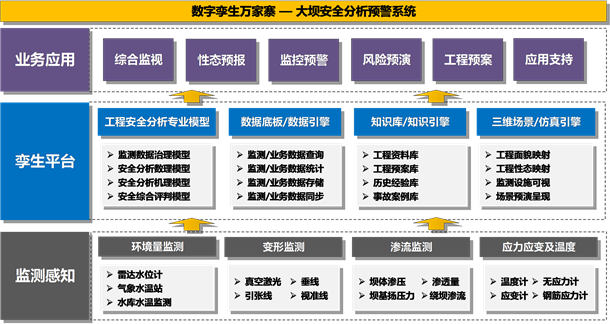
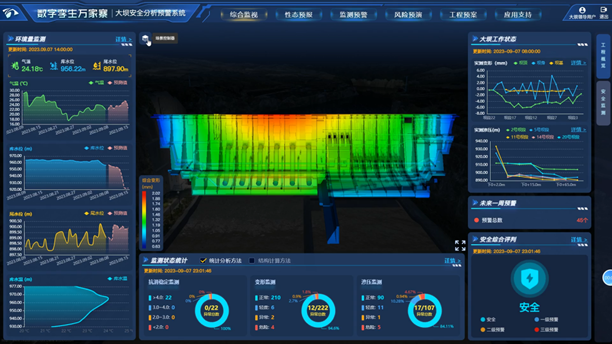
Digital Twin of Wanjiazhai Hydropower Project Safety Analysis and Early Warning System
Joining hands to protect every drop of water and build each dam smartly
The construction of smart dams is a long-term and arduous task. In the future, IWHR will continue to increase investment in scientific research, deepen scientific and technological innovation, and make further contributions to the technical system of smart dams. We will strengthen international exchanges and cooperation, share experience and explore new solutions with global water colleagues, and work together to address the challenges on dam safety. We wish, by working together, smart dams could better protect our water resources and ensure water security, and contribute to achieving the harmony between humanity and nature as well as the global sustainable development.